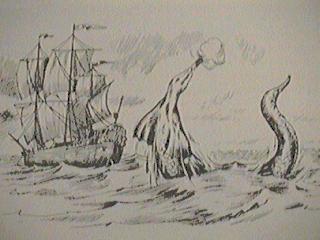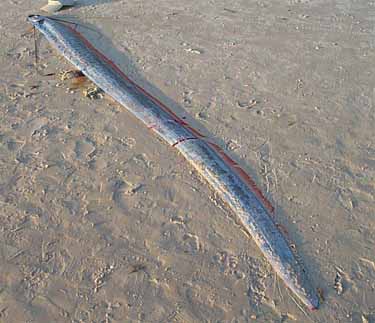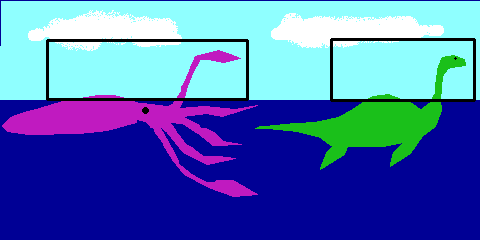pop up description layer
HOME
Cryptozoology UFO Mysteries Aviation Space & Time Dinosaurs Geology Archaeology Exploration 7 Wonders Surprising Science Troubled History Library Laboratory Attic Theater Store Index/Site Map Cyclorama

Custom Search
|
|
Sea Monsters that Weren't On a December day in 1848 the sailing ship Pekin was becalmed off the Cape of Good Hope near Southern Africa when a crew member spotted a strange creature in the water. Careful examination of the animal by use of a telescope revealed it to be snake-like, with a large head and shaggy mane. Only two months before the HMS Daedulus had reported seeing a sea serpent in that very same region. Amid great excitement a small boat, it's crew prepared to capture the animal, was lowered into the water. The captain, Frederic Smith, watched from a distance, with concern for the safety of his men, as the small boat approached the creature. To the Captain's surprise the animal did not move at all as the boat drew near. He was even more surprised when the crew of the boat proceeded to tow the "creature" back to the Pekin. The sea serpent turned out to be a twenty foot long piece of floating seaweed with a root shaped like a head and neck. Could the Daedulus sea serpent been of similar origin? Judging distance, size and motion of an object in the sea is extremely difficult. Objects on land can be compared to nearby trees and boulders. In the water only the waves offer a clue to scale and the size of waves vary enormously depending on weather conditions. The movement of the waves can also suggest motion where there is none. Arthur Adams, a ship's surgeon in the 1860's, spotted what appeared to be a mysterious creature moving through the water by using lateral undulations of it's body. His ship's course was altered to intercept the animal and capture it. When they approached the thing Adam's wrote: "By this time, however, a closer and more critical inspection had taken place, and the supposed sea monster had turned himself into a long, dark root, gnarled and twisted, of a tree, secured to the moorings of a fishing net, with a strong tide passing it rapidly, and thus giving it an apparent life-like movement and serpentine aspect." The Daedulus affair might also be explained by an abandoned native canoe painted like a snake. L. Sprague de Camp suggested the owners of the canoe may have harpooned a large sea animal, like a whale shark, and they were either spilled into the sea when the animal surfaced under the boat, or jumped in panic when they could not cut the line dragging the canoe.
One unusual, real creatures that might be mistaken for a sea monster is the oarfish. The oarfish, Regalecus glesne, is a strange eel-like animal that has been measured at up to twenty-five feet in length. Some reports have described specimens twice that size. The oarfish is bright silver in color and has a high, bright red crest of spikes running down the back of it's snake-like body. It's strange startling appearance has led it to be identified as a monster on at least one occasion: Two men were gathering seaweed on the coast of Bermuda in 1860 when they came across a serpent-like creature stranded in the rocks. They killed it and they animal was reported as a sea serpent until a naturalist eventually showed up and identified the creature for what it really was. An unusual species of frilled shark, Chlamydoselachus anguineus, might also be taken for a sea serpent. Like the oarfish it is eel-shaped. It has a single dorsal fin placed well back along the body which can appear as a mane. The frilled shark has an ancient history and is almost a living fossil. It would truly be a likely candidate for a sea serpent if it was only a little larger. So far the largest known frilled shark was only six feet nose-to-tale. If there is a larger relative of this animal swimming in the seas it might well be identified as a sea serpent. In 1880 Captain S. W. Hanna netted a long eel-like shark that measured some twenty-five feet. While not matching the description of Chlamydoselachus anguineus exactly, it probably is a close relative and suggests there may be some giant frilled sharks in the sea that could be taken for sea serpents. One dangerous candidate as a sea monster is the salt water crocodile. These creatures, living in the India Ocean and the area around south-east Asia and Australia have been measured to lengths of 18 feet and weighing almost a ton. Unconfirmed reports indicate they may get as long as thirty feet. They are hungry, aggressive and often attack people. The giant squid may account for some sea serpent sightings too. Giant squids probably qualify as sea monsters just as they are: Growing up to fifty feet long with ten arms and eyes over a foot in diameter. If the cone shaped squid head was sticking out of the water near close to a visible arm the squid might look like a serpent head and tail from a distance. (A famous serpent sighting off of Greenland, by Hans Egede, in 1745 may be explained this way) Also a single tentacle with a club of suckers on the end might look like the head and neck of a Pleisosaur. In 1875 the barque Pauline spotted a sperm whale with a snake-like creature wrapped around it's mid-section. The crew reported this sea serpent eventually dragged the whale down to it's death. More likely the "snake" was the arm of a large squid in battle with the whale. Even mundane sea animals may be mistaken for sea monsters. Fish or dolphins traveling together in a line may appear as a series of undulating humps with dorsal fins. Even a mass of low flying birds skimming across the water at a distance have been mistaken for a single sea serpent. The basking shark is one creature that is more likely to be mistaken for a sea monster after it is dead, rather than when it was alive. Basking sharks are the second largest fish in the sea and grow to lengths of 40 feet. Like the great blue whale they are harmless filter feeders with enormous mouths. The shark skims the surface of ocean eating tiny floating plankton. The water exits the shark's mouth through large gill slits on the side of the head. Because the gills of the basking shark rot quickly after death the carcass can give the appearance of having a long, narrow neck (like a pleisosaur) without the head. Several basking shark remains have been misidentified as sea monsters. Some sea monster reports may not involve just unusual creatures, but usual conditions. Right before a storm at sea, air of two different temperatures can form layers just above the surface of the sea. Perhaps seven or eight feet above the waves. The different density of the two layers can cause light to bounce forming a mirage. In this case the mirage causes objects to be elongated, as if by a fun house mirror, vertically, but not horizontally. Seals, whales and dolphins breaking the surface under these conditions will appear as thin, tall, unknown creatures. Norse men often spotted these creatures and took their appearance as an omen warning of an impending storm. Because of the strange atmospheric conditions, rather than anything supernatural, this warning was accurate.
Copyright Lee Krystek 1996. All Rights Reserved.
|
|
Related Links |
|
|





